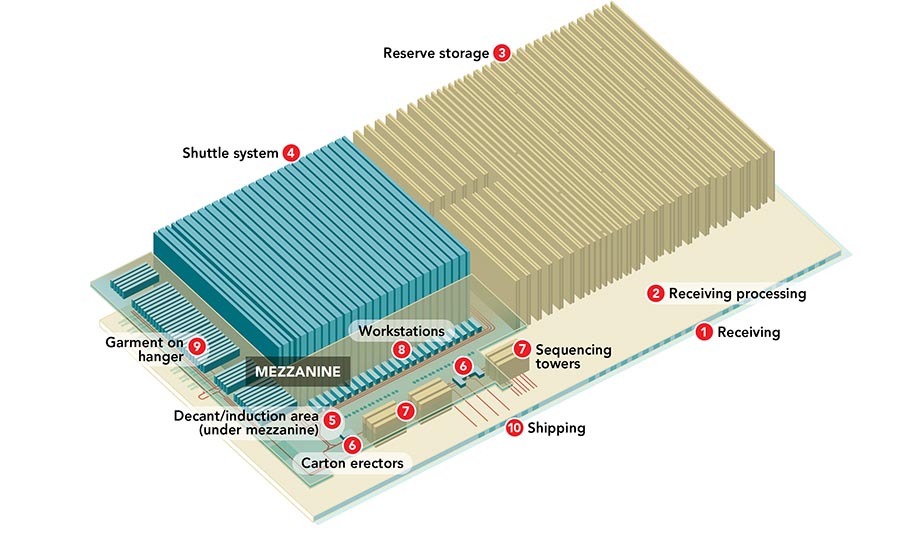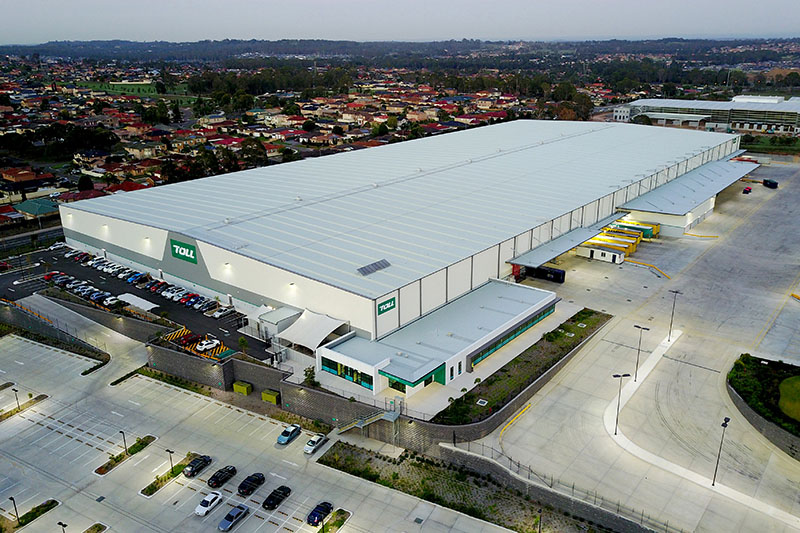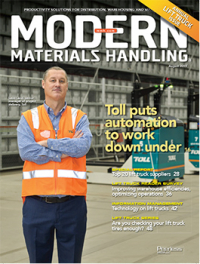Inside Toll Group’s Distribution Center: AGVs, shuttles and multi-channel fulfillment
Toll’s new Sydney-based distribution center was built from scratch to optimize e-commerce fulfillment in a unique way.
Toll Group
Sydney, Australia
Square Footage: 550,000 square feet, including 113,000 square feet of automation
Products Handled: Retail apparel and accessories
Throughput: 80,000 to 100,000 units per shift, with capacity for 170,000 units per day over two shifts
SKUS: 120,000
People/Shifts: 2 Shifts per day/ 5 days per week – 6 days per week on occasion.
Receiving
A majority of product arrives at receiving (1) in shipping containers that are manually unloaded onto reach conveyors. Every carton is automatically provided with a license plate bar code label. New product is diverted to an inbound processing area (2) where items are weighed, cubed and in some instances photographed and uploaded to a customer’s website. Other product may be diverted for value-added services.
Putaway
Once all of the processing has been completed, product is palletized and delivered by lift truck to the very narrow aisle reserve storage area (3), located on the ground floor level, where it’s putaway into storage by turret trucks. The product is now available to promise.
Replenishment
A shuttle system (4) is the engine for the goods-to-person piece picking processes, which are located on the mezzanine level. Toll uses a variety of algorithms that consider variables such as historical trading data and sales forecasts to determine the right quantity for storage of various SKUs in the shuttle system and the minimum levels that trigger replenishment from reserve storage. Associates on orderpickers pick cartons to pallets that travel through the reserve storage area. Once a pallet is complete, it’s staged at a pickup point, where an automatic guided vehicle (AGV) picks it up and delivers it to a decant and shuttle system induction area (5), located underneath the mezzanine. There, a smaller AGV places pallets on a decant table, where associates remove the items from cartons and place them in totes for induction into the shuttle system. System rules determine how product is stored in the shuttle system. The AGVs eliminate non-value-added travel from reserve storage to the decant area.
Picking
The facility processes three different types of orders: Mixed cartons for store replenishment; “click-and-collect” orders are placed online and picked up in a store; and finally, standard online orders that are shipped directly to the consumer, including “satchel orders,” which is Toll’s term for a parcel order. In all three instances, carton erectors (6) create order shipping containers that are then stored until needed in one of three order sequencing towers (7). The towers can hold empty cartons for up to 3,000 active orders. When an order is initiated, the shipping container for that order is delivered to one of the order picking workstations (8). Meanwhile, donor cartons are retrieved from storage and delivered to a workstation. Once the donor tote arrives, an order selector is directed to pick and place items for that order. If a carton requires additional items, it is conveyed to the next workstation until the order is complete.

Store replenishment
Replenishment orders are picked “store ready.” The system groups products in the carton in the right sequence for the store shelf. For instance, if a store orders polo shirts, all the red ones might go in first in the right size order, followed by all the black, yellow and purple shirts. The system can go up to seven levels.
Click-and-collect
These orders are sent to stores for pickup by the customer. Items are picked and packed by customer and then placed in a carton that is automatically optimized by size. A customized lid differentiates click-and-collect cartons from store replenishment cartons when a delivery arrives at a store.
Standard online orders
Orders that will be shipped in cartons are picked to one of two standard size cartons. Orders that will ship in satchels, or polybags, are picked first to a carton and then sent to an automatic bagging line. There, items are removed from the carton, bagged and then sent to a dispatch holding area.
Garment on hanger
The facility includes a garment on hanger picking area for items that are handled on hangers (9).
Packing
Once a store replenishment or standard online order is complete, it goes to an automated packaging area that right sizes the carton for optimal shipping. Now ready for shipping (10), the cartons are conveyed to the dispatch area until they are sorted and conveyed into the appropriate trailer.

Article Topics
Automation News & Resources
Beckhoff USA opens new office in Austin, Texas ASME Foundation wins grant for technical workforce development Walmart chooses Swisslog AS/RS and software for third milk processing facility Lucas Watson appointed CSO for Körber’s Parcel Logistics business in North America Kathleen Phelps to join FORTNA as chief financial officer Coles automates grocery distribution in Australia 2024 Intralogistics Robotics Survey: Robot demand surges More AutomationLatest in Materials Handling
Geek+ and System Teknik deploy PopPick solution for pharmacy group Med24.dk Beckhoff USA opens new office in Austin, Texas Manhattan Associates selects TeamViewer as partner for warehouse vision picking ASME Foundation wins grant for technical workforce development The (Not So) Secret Weapons: How Key Cabinets and Asset Management Lockers Are Changing Supply Chain Operations MODEX C-Suite Interview with Harold Vanasse: The perfect blend of automation and sustainability Consultant and industry leader John M. Hill passes on at age 86 More Materials HandlingAbout the Author
Subscribe to Materials Handling Magazine

Find out what the world's most innovative companies are doing to improve productivity in their plants and distribution centers.
Start your FREE subscription today.
April 2024 Modern Materials Handling

Latest Resources












